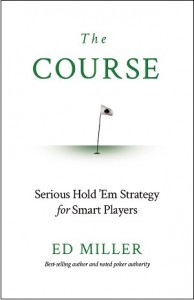INTRODUCTION
Full disclosure. I’ve been a fan of Ed Miller’s for the past 10 years, I consider him a friend after having hung out with him on several occasions, and my name appears in the Acknowledgments section of this book. In spite of these things, I feel that I am able to be objective in this review. In fact, I was able to give Tournament Poker Edge an honest and slightly negative review of a book published by one of my employers a year ago. I don’t have a financial interest in this book and even if I did, my track record shows that I would keep it real nevertheless.
That said, this book is freaking awesome!
 PART I: THE 30,000 FOOT VIEW
PART I: THE 30,000 FOOT VIEW
The premise of The Course is that when you are playing live cash game poker, your job isn’t to beat the other players. Your job is to beat the table in the same way a golfer’s job is to beat the course as opposed to the other golfers. This analogy gets a little hard to follow when you consider that in poker, the course, aka the table, is actually made up of the other players. Your job is to see the forest while ignoring the trees.
I can only imagine how confusing that must sound to someone brand new to the game of poker, but don’t fret, you’re in good hands. Ed Miller writes like he is creating a Cliff’s Notes version of a Poker for Dummies book. He’s good at breaking complex concepts down into easily digestible nuggets. In The Course, he does this to the extreme.
PART II: BEATING LIVE 1-2 GAMES
In this section, which is the first to get down to brass tacks, Miller tells you step by step how to beat most live 1-2 games. He doesn’t tell you what to do against each specific player type. Remember we are trying to ignore the individual trees. He gives you a generic plan that should work in most 1-2 games. He pretty much tells you which hands to play preflop then tells you when to bet and when to fold postflop. What else do you need to know? Of course, this strategy is not perfect, but it’s simple enough to learn quickly and it will work often enough to give you an edge in most 1-2 games.
PART III: BEATING LIVE 2-5 GAMES
In this section, Miller basically tells you how to beat the strategy he outlined in the previous section because this knowledge is what it takes to move up in stakes. Players at 2-5 have learned the tricks of successful 1-2 players and know how to use their strategy against them. For example, one of the big pieces of advice Miller gives in part II is to not put a lot of money into the pot with a bad hand. In part III, he says that if you know a player will not put a lot of money in the pot with a bad hand, then your job is to read him and the board texture to find out when he is not strong and then put a lot of money into the pot so that he will fold. Makes sense? Told you he keeps it simple, but be advised that the devil is in the details. You must do the work to get good at reading players and board textures.
PART IV: BEATING LIVE 5-10 GAMES
Once you’ve learned to beat the 2-5 course, your job is to again turn that strategy on its head in order to beat the 5-10 course. You know that when these players are putting tons of money into the pot they are often doing so to try and get a weaker player to fold. So now, Miller says that your job is to make them think that you are weak and then call them down when they try to barrel you off. The better players at this level will eventually catch on. At this point, the game devolves into a series of adjustments and readjustments until finally the best players play balanced against each other and try to get as close as possible to GTO while continuing to take shots at more exploitable players.
CONCLUSION
That’s pretty much live cash game poker in a nutshell. Seems easy enough right? Just remember that all Miller has done here is give you an overview of what you should be looking to do. That said, it takes a lot of work to get to where you need to be. Fortunately, Miller helps this process along by providing some hand quizzes at the end of each section to test your understanding of the concepts he discussed. In addition, he recommends several other books for further, more in depth reading on the concepts. If you have no idea of how to improve at poker, I highly recommend The Course as a starting point. It will narrow your focus and help you to put the most important things first.


